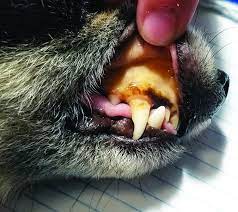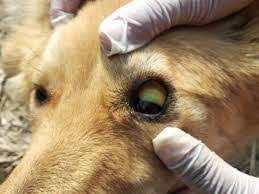Therapeutic and Preventive Measures of Jaundice in Dog
Neeraj Singh Mewari, Neeraj Kumar and Manish Kumar Verma*
Email- manishverma307@gmail.com
1, 2Department of Veterinary Pathology
3Department of Veterinary Pharmacology & Toxicology
College of Veterinary and Animal Sciences
G.B. Pant University of Agriculture & Technology Pantnagar-263145 Uttarakhand
Introduction
Jaundice, also known as icterus, is a yellow discoloration of the skin, sclerae, mucous membranes, and internal organs caused by an increase in bilirubin concentration in blood and tissues, a substance formed by red blood cell breakdown. Haemolytic (pre-hepatic) jaundice, toxic (intra-hepatic) jaundice, and obstructive (post-hepatic) jaundice are the various forms of jaundice. It is characterized by clinical sign such as loss of appetite, physical fatigue, lethargy, weight loss, increased water consumption, and frequent urination. Jaundice can be occur in dogs with blood parasites, toxins, heartworm disease, cancer, gall bladder diseases, and infectious disease like infectious canine hepatitis. Regardless of the cause, jaundice is considered abnormal in the dog. Jaundice can be easily diagnosed by appearance of yellow discoloration of animal’s skin, gum, sclera and change in color of faeces and urine. It is often more apparent in the whites of the eyes, in the skin at the base of the ears, along the gums, and in the skin of the abdomen. Jaundice generally is not a disease; rather it is a symptom of a number of canine illnesses. Treatment of jaundice is mainly based on its types. Jaundice can be successfully treated by giving hematinic, liver tonics with multivitamins. Jaundice in dogs can be prevented by routinely vaccination, deworming, control of ticks and provide balanced diet with appropriate exercise.
Etiology
Jaundice is most often caused by blood loss (hemolytic jaundice) and liver damage (hepatic jaundice), but it may also be caused by a blockage in the flow of bilirubin-containing bile or bile duct trauma. Hemolysis can be caused by a number of factors, including hemoprotozoan disease like trypanosomiasis, babesiosis, dirofileriosis, and ehrlichiosis, parasitic disease like ancylostomosis, bacterial disease like leptospirosis, viral disease- infectious canine hepatitis and parvo viral disease, autoimmune disease- autoimmune hemolytic anemia and systemic lupus erythematosus, toxicity like chronic copper and zinc poisoning, rat poisoning, onions and garlic, trauma and cancer. Liver disease and bile duct obstruction are also potential causes like hepatitis, liver tumors, pancreatitis, gall bladder stones and some toxins which lead to liver damage like paracetamol and anti-seizure medications such as phenobarbital, phenytoin, acetaminophen and sulfa drugs.
Clinical Sign and Symptoms
Dog suffering from jaundice shows yellow discoloration that is usually first recognized in the mucous membranes of unpigmented skin. Colour is most prominent in the sclera of eyes, tongue and gum. Colour may vary from lemon to orange or greenish yellow or intense yellow, depends of severity.
|
|

|
| Yellow discoloration of sclera of eyes
|
Yellow discoloration of gum |
Dog becomes lethargic with rough hair coat. Additional signs depend on the underlying cause of the jaundice in the affected dog. In general, non-specific signs such as, and partial or complete loss of appetite, lethargy, weakness, loss of body weight and increase water intake occur in many dogs, although some jaundiced dogs are otherwise asymptomatic. Many dogs show dark or discolored urine with increased frequency and orange tint faeces with offensive odour. Faeces may contain fat (Steatorrhoea), occasionally. Vomition is a common feature in dogs. In severe cases muscular spasm, excitability, comma and death can occur.
Diagnosis
Jaundice in dogs can be easily diagnosed by clinical sign and symptoms mentioned above. It can be confirmed by complete blood count (CBC) that is often the first step in the diagnosis. Blood examination like decrease hemoglobin, total erythrocyte count and change in morphology of erythrocytes reveals destruction of erythrocytes or hemolysis. If the CBC is normal, then the biochemical tests are checked to evaluate liver enzymes like aspartate aminotransferase (AST), alanine aminotransferase (ALT) and alkaline phosphatase (ALP). The ratio of the enzymes will be increased which provides a diagnosis that liver is inflamed or blocked. Urinalysis is also important to confirm the presence of bilirubin in the urine that can be identifying be change in colour. Additional tests include x-rays of the abdomen for the presence of any tumour in liver and stones in bile duct for assess the type of jaundice. Ultrasound can also be done for seeing the pancreas and gall bladder to find out if they are affected and if there is any fluid in the abdomen. Biopsy of liver can be done for detection of any inflammation. Other tests like serological tests for type of infectious diseases, coagulation profiles to assess blood clotting, as abnormal clotting may occur with severe liver disease and pancreatitis, coombs test to evaluate for immune-mediated destruction of red blood cells, van den bergh reaction and icterus index are also helpful for determine the type and extent of jaundice respectively.
Treatment
The first step of cure jaundice is correction of primary cause with appropriate measures. In case of hemolytic jaundice specific measure to be adopted to prevent further hemolysis. Anti-haemoprotozoan drugs is necessary like If dog is positive for tryanosomiasis, it is effective to inject Diaminazine aceturate @ 3.5mg/kg body weight deep intramuscular repeat once or twice, For Babesiosis, injection Berenil is also effected at the same dose with antibiotics like Doxycycline is administered orally @ 10mg/kg body weight two times in a days for 2 weeks. For Ehrlichiosis, antibiotic like Clindamycin @ 10mg/kg body weight with doxycycline 10mg/kg orally for 2 weeks is affected. Haematinic is also highly necessary to early recovery of blood loss like Syrup (aRBCe pet) @ 3-5 ml orally once daily for 2 weeks. Immune system-suppressing drugs are used to treat immune-mediated hemolysis such as corticosteroids (Prednisolone) @ 0.5 mg/kg body weight, In dogs who are severely anemic, a blood transfusion may be necessary until its cause is identified, or to allow time for other medical treatments to work. In case of hepatic jaundice it is necessary to give oral liver tonic preparation with anti-inflamatory (aspirin), broad spectrum antibiotics (Amoxicillin), antacids (Ranitidin). Your dog will also be given additional treatments based on clinical condition like multivitamin and liver tonic syrup orally daily for 2 weeks. Fluid especially dextrose therapy either orally or parentrally (DNS 5 or 10%) is very much needed in all type of jaundice. In obstructive jaundice, the cause of obstruction should be determined. If it is due to Internal parasites timely deworming should be done by broad spectrum anthelmintic drug like Tablet Easypet (Praziquantel, Pyrantel pamoate, and Fenbendazole) @ 1 tab for 10 kg body weight once and repeat every 3 months. If obstructive is due to stone or cancerous growth surgical intervention or chemotherapy is necessary as soon as possible. Other possible home remedies are Turmuric (Haldi), about a teaspoon with milk orally once or twice for a large dog work as an antioxidant and anti-inflammatory. Dandelion leaves (Sinhaparnee pattee) also helps in improving liver function, it is known to suppress fat accumulation in the liver. A good diet helps in early recovery for provide nutrient and boosting immunity. At home we can make up a diet according to these suggestions. Diet should be fat and salt free. Do not give fatty meat, organs (beef liver, kidneys, etc.), pork, duck, or salmon. Soluble fiber sources like oatmeal help remove ammonia from dog’s system so that their liver will have to work a little less hard. You can also give pumpkin that is another good source of fiber. Add a dose of fish oil or salmon oil to dog’s meals. These oils are rich in omega-3 fatty acids and can help reduce inflammation within the liver. Coconut oil provides fat in the form of medium-chain triglycerides and may also offer antibacterial and antiviral effects. Papaya is palatable and provides additional calories without stressing the liver. If dog has not eaten this fruit before, however, you should make sure to hand-feed them and that they like the taste. Rest is also necessary for early recovery.
Prevention
Routine vaccinations by Polyvalent vaccine (Megavac 7 in 1) @ 1 ml subcutaneous route once at 6 to 8 weeks. Booster dose should be done after one month then annually, protect against infectious hepatitis caused by Adenovirus and Leptospira species of bacteria. The vaccine should be maintained in cold chain. Regular deworming is also necessary along with vaccination for control of internal parasites that cause obstructive jaundice. Deworming should start with 2 to 3 week of age after repeat every 2 week until 3 month of age, than once in 3 month. If the jaundice is due to excessive hemolysis, the cause of the hemolysis dictates its treatment. Avoid rearing of breed that is susceptible to Auto-immune disease like collies, German Shephered and Beagles. Dog food should be balanced with contain all nutrients free from toxic substances. Dog should be provides proper rest and timely exercise which is necessary for maintain immunity.
Conclusion
Jaundice in dogs is a common clinical condition but it could be successfully treated if their respective diseases are identified and treated successfully. As with all disease signs, the outcome in a jaundiced dog depends primarily on the underlying cause of the jaundice and on the animal’s response to treatment. Dogs with pre-hepatic jaundice due to hemolysis may recover completely. Dogs with jaundice due to primary liver disease may recover completely, especially if the problem was drug or toxin related. Prognosis in these cases is good if further exposure to the drug or toxin is avoided and supportive care is provided as necessary. In case of obstructive jaundice due to bile duct or gallbladder cancer usually do not survive for long periods of time. In dogs with bile duct obstruction secondary to pancreatitis, the prognosis is best if the obstruction resolves without surgical intervention.




